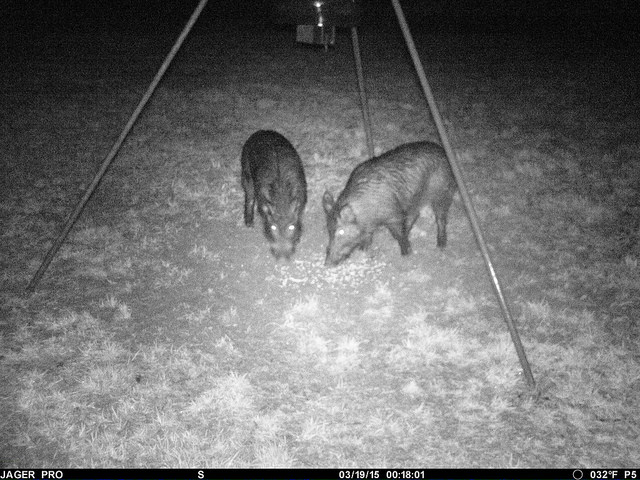March 9, 2021
Feral hog eradication resources, conservation assistance available to Buffalo River Watershed landowners
By Ryan McGeeney
U of A System Division of Agriculture
Fast Facts:
- $2 million in assistance grants to be awarded over the next 5 years
- Current application window open until March 26
- Additional information on feral hog eradication available through Cooperative Extension Service
(442 words)
LITTLE ROCK — Landowners in the Buffalo River Watershed are eligible to receive assistance from the U.S. Department of Agriculture aimed at eradicating feral hog populations in the area.
Additionally, as part of the Buffalo River Watershed Enhancement Project, funding for conservation assistance is also currently available to landowners as well as agricultural producers in the watershed who are interested in implementing conservation practices to help maintain and improve water quality.
The sign-up period for conservation practices ends March 26, 2021. Interested landowners should check in with their local USDA Natural Resources Conservation Service field office to apply.
John Pennington, extension water quality educator for the University of Arkansas System Division of Agriculture, said there will be multiple sign-up opportunities for this special assistance over the next five years with up to $400,000 additional conservation funding available for qualifying landowners annually.
“The importance is that not only can these forms of conservation assistance help protect water quality in the watershed, but they can also improve farm profitability and habitat for native wildlife,” Pennington said. “Also of importance, this opportunity does not come around every day, or even very often.”
The Cooperative Extensions Service, part of the Division of Agriculture, is helping to provide site visits, outreach and information within the project area, as well as providing feral hog control informational resources.
While the funding is potentially available throughout the Buffalo River Watershed, priority areas are Calf Creek, Bear Creek, Lower Big Creek, Tomahawk Creek and Brush Creek sub-watersheds in portions of Baxter, Marion, Pope, Searcy, Stone and Van Buren counties.
The funded conservation practices are intended to increase farm efficiency and reduce nutrients, sediment, and bacteria from moving off the landscape and into tributaries, and align with the recommendations from the Buffalo River Watershed Management Plan. Some examples of supported conservation practices include brush management, prescribed burning and pasture fencing.
Feral hog eradication
To receive assistance with feral hog eradication, landowners should call the USDA
Animal and Plant Health Inspection Service (APHIS) Arkansas Wildlife Services at (501)
835-2318. Wildlife Service technicians use state-of-the-art technology, including
remotely triggered enclosure gates, to trap and remove feral hogs from residents’
property.
Other agencies and organizations on the Arkansas Feral Hog Eradication Task Force are available to help. Residents who prefer to learn how to trap hogs themselves using new technologies, and are willing to host a field demonstration, or would like to pick up an Arkansas Feral Hog Handbook, contact your local county extension office (Uaex.uada.edu).
Other steps to help in the eradication of feral hogs and improvement of water quality are to report sightings and kills of feral hogs using the Feral Hog Reporting Survey 123 app from the Arkansas Feral Hog Eradication Task Force, available at https://www.agriculture.arkansas.gov/arkansas-department-of-agriculture-services/feral-hog/. Learn more about methods for effective control at https://www.uaex.uada.edu/environment-nature/wildlife/feral-hogs.aspx.
To learn more about extension programs in Arkansas, contact your local Cooperative Extension Service agent or visit uaex.uada.edu. Follow us on Twitter at @UAEX_edu.
About the Division of Agriculture
The University of Arkansas System Division of Agriculture’s mission is to strengthen agriculture, communities, and families by connecting trusted research to the adoption of best practices. Through the Agricultural Experiment Station and the Cooperative Extension Service, the Division of Agriculture conducts research and extension work within the nation’s historic land grant education system.
The Division of Agriculture is one of 20 entities within the University of Arkansas System. It has offices in all 75 counties in Arkansas and faculty on five system campuses.
Pursuant to 7 CFR § 15.3, the University of Arkansas System Division of Agriculture offers all its Extension and Research programs and services (including employment) without regard to race, color, sex, national origin, religion, age, disability, marital or veteran status, genetic information, sexual preference, pregnancy or any other legally protected status, and is an equal opportunity institution.
# # #
Media contact:
Ryan McGeeney
Communications Services
University of Arkansas System Division of Agriculture
Cooperative Extension Service
(501) 671-2120
rmcgeeney@uada.edu
